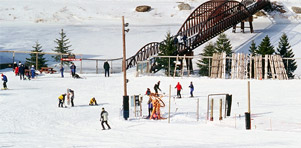Type II Skier (Intermediate)
Moderate skiing at average visual indicator settings
- Prefer a variety of speeds
- Prefer varied terrain
- Type II settings apply to skiers who do not meet all the descriptions of Type I or Type III classifications
Killington Resort, the largest ski and snowboard resort in eastern North America, is known for long seasons, abundant natural snowfall, and the most extensive snow-making system in the world. Killington covers more than 750 acres, featuring 71 miles of diverse terrain on 141 trails, and provides skiers and riders of all ability levels a choice of wide-open groomed cruisers, narrow classic New England runs, moguls, steeps, and 13 tree skiing areas. Killington’s nationally recognized terrain parks at Bear Mountain offer freeskiers and riders multiple features for jibbing and jumping, including a 430-foot-long Superpipe with 18-foot walls.
The Woods are the goods.
Shredding in the snowy woods has always been the purest experience in snowboarding, the roots of freestyle. Jake and the Burton Team have teamed up with Killington and four other resorts worldwide to create the evolution of freestyle snowboard parks in the ultimate natural environment: The Stash. Taking advantage of natural terrain, local wood products, and all the creative elements the mountain has to offer, The Stash will take your freestyle riding to the next level. From rainbow log jibs and misty road gaps to hidden pow slashes and fast banks, The Stash mixes the best of every trail into one, wooded run that will test your riding flow. And better yet, The Stash was developed with the future of the mountain environment in mind. From the re-use of local trees and found objects to on-hill recycling, The Stash is designed to have more impact on your riding and less impact on the environment. Find your own line and take your freestyle riding to where the woods are the goods: The Stash.
Meet at Commonwealth EMS Store at 5:00am and Harvard Square 5:15am. We will depart the mountain at 4:00pm.
Basic Package (includes a round-trip bus pass and an all-mountain lift ticket) $95.00
Full Beginner Package (includes a round-trip bus pass, a lower mountain lift ticket, 90-minute group lesson, and ski or board rental) $129.00
Round-Trip Transportation $55.00
One-Way Transportation $45.00
Rentals (Ski or Board) (boots, poles, and A-shaped skis; or boots, boards, and bindings) $35.00/day
Lift Ticket (all-mountain lift ticket) $55.00
Group Lesson (beginner, advanced beginner, or intermediate) $32.00
A parent or legal guardian must complete and bring along a Minor Permissions Slip for each child age sixteen (16) and under.
Your bindings settings usually follow your batting stance. If you are right-handed and bat right-handed, then you will probably feel most comfortable with your left foot forward (regular). If you are left-handed or bat “lefty,” then you will likely feel right foot forward is more natural (goofy).
These are just guidelines to start. We can help you find the right fit for your ride.

Determining your ski ability is your responsibility!
Your ski ability, height, weight, age, and boot-sole length are used by the shop to determine the visual indicator settings of your ski bindings. Be sure to provide accurate information, as any error may increase your risk of injury. Consult the skier type descriptions to select your classification. These descriptions are compatible with ASTM and ISO documents.
Cautious skiing at lower visual indicator settings
Moderate skiing at average visual indicator settings
Aggressive skiing at higher visual indicator settings